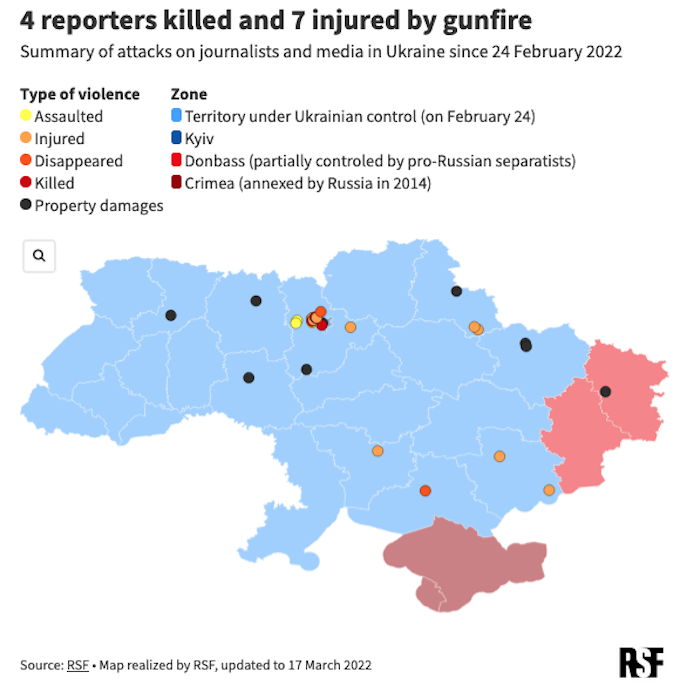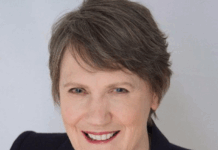
Pacific Media Watch newsdesk
Several media crews have already come under fire and four reporters have sustained gunshot injuries in Ukraine since the start of the Russian invasion as it enters its fourth week.
Reporters Without Borders (RSF) has reaffirmed its call to the Russian and Ukrainian authorities to comply with their international obligations to guarantee the safety of reporters in the field, and urges journalists to take the utmost care.
- READ MORE: Читать на русском / Read in Russian
- RSF opens press freedom centre in Lviv, first bulletproof vests delivered
- RSF creates ‘mirror’ of leading Russian exile news site blocked by Kremlin
- RSF refers Russian strikes on four Ukrainian TV towers for ICC probe
The shots came within centimetres of Swiss photographer Guillaume Briquet’s head when presumed members of a Russian special commando fired on him shortly after he passed a Ukrainian checkpoint on a road towards the southern city of Mykolaiv on March 6, while covering the Russian advance in the region.
Despite the many “Press” markings on his car and his bulletproof vest marked “Press,” this experienced war reporter was then harassed by the soldiers, who stole 3000 euros and reporting equipment from him.
“As this incident clearly illustrates, reporters in the field are targets for belligerents despite all the rules protecting journalists,” said Jeanne Cavelier, the head of RSF’s Eastern Europe and Central Asia desk.
“They are civilians, who are keeping the world informed about the progress of the fighting. They must be able to work safely. We therefore call on all parties to the conflict to immediately commit to protecting journalists in the field in accordance with international law.
“We also recommend that journalists exercise the utmost caution in the light of the many attacks by Russian commandos sent ahead as scouts.”
Under Russian fire
“They were less than 50 metres away,” RSF was told by Briquet, who was wounded in the face and arm by glass splinters from his windshield.
“They clearly shot to kill. If I hadn’t ducked, I would have been hit. I’ve been fired on before in other war zones, but I’ve never seen this.

“Journalists traveling around the country with no war experience are in mortal danger.”
A crew working for the London-based pan-Arab TV channel Al-Araby TV — reporter Adnan Can and cameraman Habip Demirci — came under Russian fire in Irpin, a suburb of Kyiv, on March 6. Shots were aimed at their car even though they had attached a white flag and “Press” signs to it.
Trapped in a town where fighting was taking place, the two journalists had to hide with residents.
A crew with the UK’s Sky News TV channel — consisting of four Brits and a Ukrainian journalist – came under fire from a Russian reconnaissance unit while heading toward Bucha, on the outskirts of Kyiv, on the fourth day of the invasion, February 28.
The crew’s leader, reporter Stuart Ramsay, sustained a gunshot injury to the lower back while cameraman Richie Mockler’s body armour stopped two other rounds.
After shouting that they were journalists and after seeing that the shooting continued despite their press vests, the crew had to abandon their vehicle and run for cover.
Brush with death
Vojtech Bohac and Majda Slamova, two Czech journalists reporting for Voxpot, and two Ukrainian journalists with Central TV had more luck during a similar incident while travelling together in a car in Makariv, another town on the outskirts of Kyiv, on March 3.
They managed to escape uninjured in their car after coming under fire from Russian soldiers using AK-47 assault rifles, their media outlets reported.
“This shoulder wound missed costing me my life by just a few centimetres,” Danish journalist Stefan Weichert told RSF. He is now hospitalised in Denmark after being evacuated along his colleague, Emil Filtenborg Mikkelsen, who sustained four gunshot wounds in the same attack.
The two reporters for the Danish newspaper Ekstra-Bladet sustained these injuries in the northeastern town of Okhtyrka on 26 February.
“The gunman, who we weren’t able to identify, was located about 15 metres behind our car.” Weichert said. “He couldn’t have failed to see the ‘press’ sign that was clearly visible on our car.”
4 TV towers bombed
As well as firing live rounds at reporters, the Russian armed forces have also carried out strikes on telecommunications antennae to prevent Ukrainian TV and radio broadcasts. Four radio and TV towers — in Kyiv, Korosten, Lyssytchansk and Kharkiv — have been the targets of Russian attacks that abruptly terminated broadcasting by at least 32 TV channels and several dozen national radio stations.
Evgeny Sakun, a cameraman for the local Kyiv Live TV channel, was at the Kyiv tower at the time of the attack and was killed in circumstances that RSF is investigating.
Ukraine is ranked 97th out of 180 countries in RSF’s 2021 World Press Freedom Index, while Russia is ranked 150th.
Pacific Media Watch collaborates with Reporters Without Borders.






































